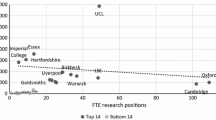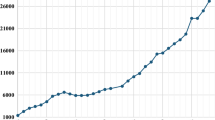Abstract
A possible side effect of several research evaluation schemes adopted by governments and research organizations is the discouragement of research diversification and cross-discipline fertilization, which are crucial for major global scientific challenges. This work intends to contribute to the literature stream investigating such initiatives’ effects on scientists’ specialization/diversification strategies. To this purpose, we analyze the response of academics to the introduction of the national scientific accreditation (ASN) for professorship introduced in Italy in 2012. We will conduct a longitudinal disciplinary analysis of the publications of each Italian university professor in the sciences (over 25.000), accounting for those individual and contextual variables that might moderate the opportunistic response to the ASN incentive scheme.



Similar content being viewed by others
Notes
Presidential decree 222 of 14/09/2011.
Ministry of Education, Universities and Research Ministerial decree 76 of 07/06/2012.
Initially the regulations required achievement of thresholds in all the three indicators, but after heated debate this was modified in consideration of the conditions of different sectors.
The reason for introducing the CSs, unifying two or more SDSs into a single CS, is probably to reduce the number of accreditation committees, and therefore evaluators. SDSs were unified based on cognitive proximity and number of professors falling into them.
For the “non-bibliometric” CSs, the indicators were not based on citations.
For applicants to positions as evaluation committee members, the indicators were the number and the impact of overall scientific production, without normalization for years of academic seniority.
Such data were retrieved from the ASN pages of the MIUR website http://abilitazione.miur.it/public/candidati.php?sersel=50&, but are no longer available. Subject to regulation, the ministry withdrew most data 60 days after the committee decisions, leaving only the lists of successful candidates.
For each professor this database provides information on their name and surname, gender, affiliation, SDS and academic rank, at close of each year. http://cercauniversita.cineca.it/php5/docenti/cerca.php, last access on 9 January 2024.
The harmonic average of precision and recall (F-measure) of authorships, as disambiguated by the algorithm, is around 97% (2% margin of error, 98% confidence interval).
The sum of the values referred to the listed SCs is above 55, due to publications hosted in multi-SC journals.
We observe a five year period to avoid the random fluctuations of yearly observations.
To build the variable StatusASN, we refer to the 2012 academic rank, just before the ASN. If the professor has no records in 2012 (due to no publications in that year), we refer to the academic rank in the latest observed year. Note that the dataset does not distinguish whether an assistant professor would be seeking accreditation for advancement to associate or full professor, however the latter case would be so rare that it can be ignored.
0.226% = EXP(0.00226)—1.
References
Abramo, G., & D’Angelo, C. A. (2015). An assessment of the first “scientific accreditation” for university appointments in Italy. Economia Politica-Journal of Analytical and Institutional Economics, 32(3), 329–357.
Abramo, G., & D’Angelo, C.A. (2023). The effect of bibliometric research performance assessment on the specialization vs diversification strategies of scientists. Proceedings of the 19th International Society of Scientometrics and Informetrics Conference - (ISSI 2023) 2–5 July 2023, Bloomington, Indiana-US.
Abramo, G., D’Angelo, C. A., & Di Costa, F. (2018a). The effects of gender, age and academic rank on research diversification. Scientometrics, 114(2), 373–387.
Abramo, G., D’Angelo, C. A., & Di Costa, F. (2019). Diversification versus specialization in scientific research: Which strategy pays off? Technovation, 82–83, 51–57.
Abramo, G., D’Angelo, C. A., & Grilli, L. (2021). The effects of citation-based research evaluation schemes on self-citation behaviour. Journal of Informetrics, 15(4), 101204.
Abramo, G., D’Angelo, C. A., & Rosati, F. (2015). The determinants of academic career advancement: Evidence from Italy. Science and Public Policy, 42(6), 761–774.
Abramo, G., D’Angelo, C. A., & Zhang, L. (2018b). A comparison of two approaches for measuring interdisciplinary research output: The disciplinary diversity of authors vs the disciplinary diversity of the reference list. Journal of Informetrics, 12(4), 1182–1193. https://doi.org/10.1016/j.joi.2018.09.001
Allmendinger, J. (2015). Quests for interdisciplinarity: A challenge for the ERA and HORIZON 2020 Policy Brief by the Research, Innovation, and Science Policy Experts (RISE). Luxembourg: Publications Office of the European Union. https://op.europa.eu/en/publication-detail/-/publication/0309a87c-7276-11e5-9317-01aa75ed71a1/language-en. Last access 9 January 2024.
Bateman, T. S., & Hess, A. M. (2015). Different personal propensities among scientists relate to deeper vs broader knowledge contributions. Proceedings of the National Academy of Sciences, 112(12), 3653–3658.
Belkhouja, M., Fattoum, S., & Yoon, H. D. (2021). Does greater diversification increase individual productivity? The moderating effect of attention allocation. Research Policy, 50(6), 104256.
Chakraborty, T., Tammana, V., Ganguly, N., & Mukherjee, A. (2015). Understanding and modeling diverse scientific careers of researchers. Journal of Informetrics, 9(1), 69–78.
Cummings, J. N., & Kiesler, S. (2014). Organization theory and the changing nature of science. Journal of Organization Design, 3(3), 1–16.
D’Angelo, C. A., Giuffrida, C., & Abramo, G. (2011). A heuristic approach to author name disambiguation in bibliometrics databases for large-scale research assessments. Journal of the American Society for Information Science and Technology, 62(2), 257–269.
de Rijcke, S., Wouters, P. F., Rushforth, A. D., Franssen, T. P., & Hammarfelt, B. (2016). Evaluation practices and effects of indicator use-a literature review. Research Evaluation, 25(2), 161–169.
Della Sala, S., & Brooks, J. (2008). Multi-authors’ self-citation: A further impact factor bias? Cortex, 44(9), 1139–1145.
Edwards, M. A., & Roy, S. (2017). Academic research in the 21st Century: Maintaining scientific integrity in a climate of perverse incentives and hypercompetition. Environmental Engineering Science, 34(1), 51–61.
Fang, F. C., Steen, R. G., & Casadevall, A. (2012). Misconduct accounts for the majority of retracted scientific publications. Proceeding of the National Academy of Science, 109(42), 17028–17033.
Fontana, M., Iori, M., Sciabolazza, V. L., & Souza, D. (2022). The interdisciplinarity dilemma: Public versus private interests. Research Policy, 51(7), 104553.
Franzoni, C., & Rossi-Lamastra, C. (2017). Academic tenure, risk-taking and the diversification of scientific research. Industry and Innovation, 24(7), 691–712.
Gerosa, M. (2001). Competition for academic promotion in Italy. Lancet, 357(9263), 1208–1208.
Haustein, S., & Larivière, V. (2015). The use of bibliometrics for assessing research: Possibilities, limitations and adverse effects. In I. M. Welpe, J. Wollersheim, S. Ringelhan, & M. Osterloh (Eds.), Incentives and Performance (pp. 121–139). Springer International Publishing.
Hazelkorn, E. (2010). Pros and cons of research assessment, in World Social Science Report. Knowledge Divides 2010 (UNESCO Press, 2010), pp. 255–58.
Hicks, D. (2012). Performance-based university research funding systems. Research Policy, 41(2), 251–261.
Honig, B., & Bedi, A. (2012). The fox in the hen house: A critical examination of plagiarism among members of the academy of management. Academy of Management. Learning and Education, 11(1), 101–123.
Jamali, H. R., Abbasi, A., & Bornmann, L. (2020). Research diversification and its relationship with publication counts and impact: A case study based on Australian professors. Journal of Information Science, 46(1), 131–144.
Leahey, E., Beckman, C. M., & Stanko, T. L. (2017). Prominent but less productive: The impact of interdisciplinarity on scientists’ research. Administrative Science Quarterly, 62(1), 105–139.
Leahey, E., Keith, B., & Crockett, J. (2010). Specialization and promotion in an academic discipline. Research in Social Stratification and Mobility, 28(2), 135–155.
Nagin, D. S., Rebitzer, J. B., Sanders, S., & Lowell, J. T. (2002). Monitoring, motivation, and management: The determinants of opportunistic behaviour in a field experiment. American Economic Review, 92(4), 850–873.
Nagle, F., & Teodoridis, F. (2020). Jack of all trades and master of knowledge: The role of diversification in new distant knowledge integration. Strategic Management Journal, 41(1), 55–85.
National Academies of Science, National Academy of Engineering, and Institute of Medicine. (2005). Facilitating Interdisciplinary Research. The National Academies Press.
Perotti, R. (2008). L’università truccata. Einaudi, Torino ISBN: 978–8–8061–9360–7.
Pinheiro, H., Durning, M., & Campbell, D. (2022). Do women undertake interdisciplinary research more than men, and do self-citations bias observed differences? Quantitative Science Studies, 3(2), 363–392.
Porter, A., & Rafols, I. (2009). Is science becoming more interdisciplinary? Measuring and mapping six research fields over time. Scientometrics, 81(3), 719–745.
Rafols, I., Leydesdorff, L., O’Hare, A., Nightingale, P., & Stirling, A. (2012). How journal rankings can suppress interdisciplinary research: A comparison between Innovation Studies and Business & Management. Research Policy, 41(7), 1262–1282.
Rekers, J. V., & Hansen, T. (2015). Interdisciplinary research and geography: Overcoming barriers through proximity. Science and Public Policy, 42(2), 242–254.
Schuitema, G., & Sintov, N. (2017). Should we quit our jobs? Challenges, barriers and recommendations for interdisciplinary energy research. Energy Policy, 101, 246–250.
Seeber, M., Cattaneo, M., Meoli, M., & Malighetti, P. (2019). Self-citations as strategic response to the use of metrics for career decisions. Research Policy, 48(2), 478–491.
Sidiropoulos, A., Katsaros, D., & Manolopoulos, Y. (2007). Generalized Hirsch h-index for disclosing latent facts in citation networks. Scientometrics, 72(2), 253–280.
Stephan, P. (2012). How economics shapes science. Harvard University Press.
Tripodi, G., Chiaromonte, F., & Lillo, F. (2020). Knowledge and social relatedness shape research portfolio diversification. Scientific Reports, 10(1), 1–12.
van Rijnsoever, F. J., & Hessels, L. K. (2011). Factors associated with disciplinary and interdisciplinary research collaboration. Research Policy, 40(3), 463–472.
Wilsdon, J. (2015). The metric tide: Independent review of the role of metrics in research assessment and management. Sage.
Wuchty, S., Jones, B. F., & Uzzi, B. (2007). The increasing dominance of teams in production of knowledge. Science, 316(5827), 1036–1039.
Zagaria, C. (2007). Processo all’università. Cronache dagli atenei italiani tra inefficienze e malcostume. Dedalo.
Zeng, A., Shen, Z., Zhou, J., Fan, Y., Di, Z., Wang, Y., Havlin, S. (2019). Increasing trend of scientists to switch between topics. Nature Communications, 10(1), 1–11.
Acknowledgements
This manuscript is an extended version of a previous work presented at the 19th International Society of Scientometrics and Informetrics Conference—(ISSI 2023) 2-5 July 2023, Bloomington, Indiana, (Abramo & D’Angelo, 2023). This research was co-funded by the Italian Ministry of Education, Universities, and Research, BANDO PRIN 2017NKWYFC “The effects of evaluation on academic research: knowledge production and methodological issues”.
Author information
Authors and Affiliations
Corresponding author
Ethics declarations
Competing interests
None of the authors have a conflict of interest in the subject matter or materials discussed in this manuscript.
Additional information
Publisher's Note
Springer Nature remains neutral with regard to jurisdictional claims in published maps and institutional affiliations.
Rights and permissions
Springer Nature or its licensor (e.g. a society or other partner) holds exclusive rights to this article under a publishing agreement with the author(s) or other rightsholder(s); author self-archiving of the accepted manuscript version of this article is solely governed by the terms of such publishing agreement and applicable law.
About this article
Cite this article
Abramo, G., D’Angelo, C.A. & Di Costa, F. Do research assessment systems have the potential to hinder scientists from diversifying their research pursuits?. Scientometrics (2024). https://doi.org/10.1007/s11192-024-04959-8
Received:
Accepted:
Published:
DOI: https://doi.org/10.1007/s11192-024-04959-8




